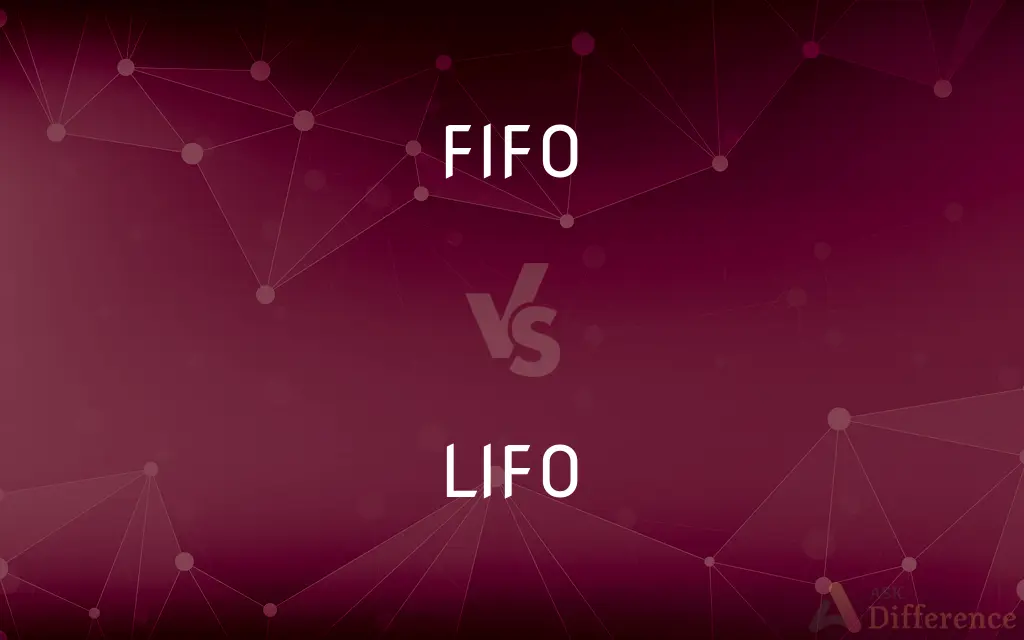FIFO vs. LIFO — What's the Difference?
By Tayyaba Rehman & Maham Liaqat — Published on February 29, 2024
FIFO (First In, First Out) assumes the oldest inventory items are sold first, while LIFO (Last In, First Out) assumes the newest items are sold first, affecting accounting and inventory management.

Difference Between FIFO and LIFO
Table of Contents
ADVERTISEMENT
Key Differences
FIFO, standing for First In, First Out, is an inventory management method where the oldest stock (first-in) is sold or used first (first-out). This approach is intuitive, mirroring the natural flow of goods in many industries, and tends to reflect a more accurate value of ending inventory on the balance sheet. LIFO, or Last In, First Out, conversely assumes the most recently acquired inventory is sold or used first. This method can lead to lower net income on paper in times of inflation, as the cost of goods sold (COGS) is based on the cost of more recent, and presumably more expensive, purchases.
In a FIFO system, the cost of goods sold reflects the cost of the oldest inventory, which, in periods of inflation, would typically be lower than more recently acquired inventory. This can result in higher reported profits and, consequently, higher taxes. LIFO, on the other hand, can reduce taxable income in inflationary periods since the COGS will reflect the higher costs of more recent purchases, reducing the reported profit.
The choice between FIFO and LIFO can significantly impact a company's financial statements. FIFO can lead to a higher asset value on the balance sheet due to the higher value of remaining inventory. In contrast, LIFO can result in a lower ending inventory value but potentially better cash flow due to lower tax liabilities in the short term.
Companies may choose FIFO for its alignment with the actual flow of goods, making it more realistic for physical inventory management and easier for tracking purposes. LIFO, while less intuitive in terms of physical flow, can be strategically used for financial reporting and tax advantages, particularly in industries where inventory items are relatively interchangeable.
The method chosen not only affects financial reporting and taxes but also inventory management strategies and operational decisions. For instance, FIFO is often preferred in perishable goods industries to prevent spoilage, while LIFO might be used in non-perishable industries to leverage tax benefits.
ADVERTISEMENT
Comparison Chart
Inventory Valuation
Based on oldest inventory cost
Based on most recent inventory cost
COGS in Inflation
Lower, older, cheaper inventory sold first
Higher, newer, more expensive inventory sold first
Reported Profit
Higher in inflationary periods
Lower in inflationary periods
Tax Implication
Potentially higher taxes due to higher profit
Potentially lower taxes due to lower profit
Realism in Physical Flow
Reflects actual physical flow of goods
Does not typically reflect physical flow of goods
Compare with Definitions
FIFO
Oldest inventory sold first.
A bakery sells its oldest bread first to maintain freshness.
LIFO
Newest inventory sold first.
A warehouse sells the most recently received construction materials first.
FIFO
Higher ending inventory value in inflation.
A retailer's ending inventory is valued at more recent, higher prices.
LIFO
Lower ending inventory value in inflation.
A manufacturer's ending inventory is valued at older, lower prices.
FIFO
Potentially higher reported profits.
A technology store reports higher profits by selling older, cheaper stock first.
LIFO
Used for tax advantages.
A business strategically uses LIFO to lower its tax liabilities during inflationary times.
FIFO
Common in perishable goods industries.
A grocery store uses FIFO to ensure produce is sold before spoiling.
LIFO
Can reduce taxable income.
An electronics retailer reduces its taxable income by selling the newest, most expensive items first.
FIFO
Reflects natural goods flow.
A car dealership sells older models before newer arrivals.
LIFO
Less reflective of physical flow.
A coal supplier accounts for sales using LIFO, though actual sales may use older stock first.
FIFO
An accounting method in which goods in inventory are valued at the price of the most recent acquisition of each type of goods, and those used up from inventory are valued at the cost of those first acquired.
LIFO
Inventory accounting in which the most recently acquired items are assumed to be the first sold
FIFO
Inventory accounting in which the oldest items (those first acquired) are assumed to be the first sold
Common Curiosities
Why might a company choose LIFO?
A company might choose LIFO for tax benefits, particularly in inflationary times, as it can lower taxable income.
Does FIFO or LIFO result in higher inventory valuation during inflation?
FIFO typically results in a higher inventory valuation during inflation.
Can companies switch between FIFO and LIFO?
Switching methods is permissible but requires regulatory approval due to potential impacts on financial reporting.
How does LIFO affect a company's financial statements?
LIFO can lead to lower net income and lower ending inventory values on the balance sheet.
What is FIFO best suited for?
FIFO is best suited for perishable goods and industries where inventory spoilage is a concern.
Which inventory method is more commonly used globally?
FIFO is more commonly used globally and is required by some accounting standards outside the U.S.
How do FIFO and LIFO impact supply chain decisions?
The choice between FIFO and LIFO can influence supply chain strategies, including purchasing and stock replenishment.
Is LIFO permitted under all accounting standards?
LIFO is not permitted under IFRS, which is used by many countries outside the U.S.
Is FIFO more intuitive than LIFO?
Yes, FIFO is more intuitive and mirrors the actual physical flow of goods in most situations.
What is the main disadvantage of LIFO?
LIFO can distort inventory value and profit margins, making financial analysis more complex.
How do FIFO and LIFO affect COGS?
FIFO usually results in lower COGS in inflationary periods, while LIFO leads to higher COGS.
What are the tax implications of using FIFO?
Using FIFO can result in higher taxes due to higher profits from the sale of older, cheaper inventory.
Does LIFO always reduce taxes?
LIFO can reduce taxes in inflationary periods but may not be advantageous in times of stable or decreasing prices.
Can FIFO and LIFO be used simultaneously?
Companies generally must choose one method for financial reporting, but they may use different methods for internal purposes.
How do businesses justify their choice of inventory method?
Businesses must justify their choice based on the nature of their inventory, tax implications, and financial reporting requirements.
Share Your Discovery

Previous Comparison
One-Punch Man Webcomic vs. One-Punch Man Manga
Next Comparison
Gratuity vs. PensionAuthor Spotlight
Written by
Tayyaba RehmanTayyaba Rehman is a distinguished writer, currently serving as a primary contributor to askdifference.com. As a researcher in semantics and etymology, Tayyaba's passion for the complexity of languages and their distinctions has found a perfect home on the platform. Tayyaba delves into the intricacies of language, distinguishing between commonly confused words and phrases, thereby providing clarity for readers worldwide.
Co-written by
Maham Liaqat













































